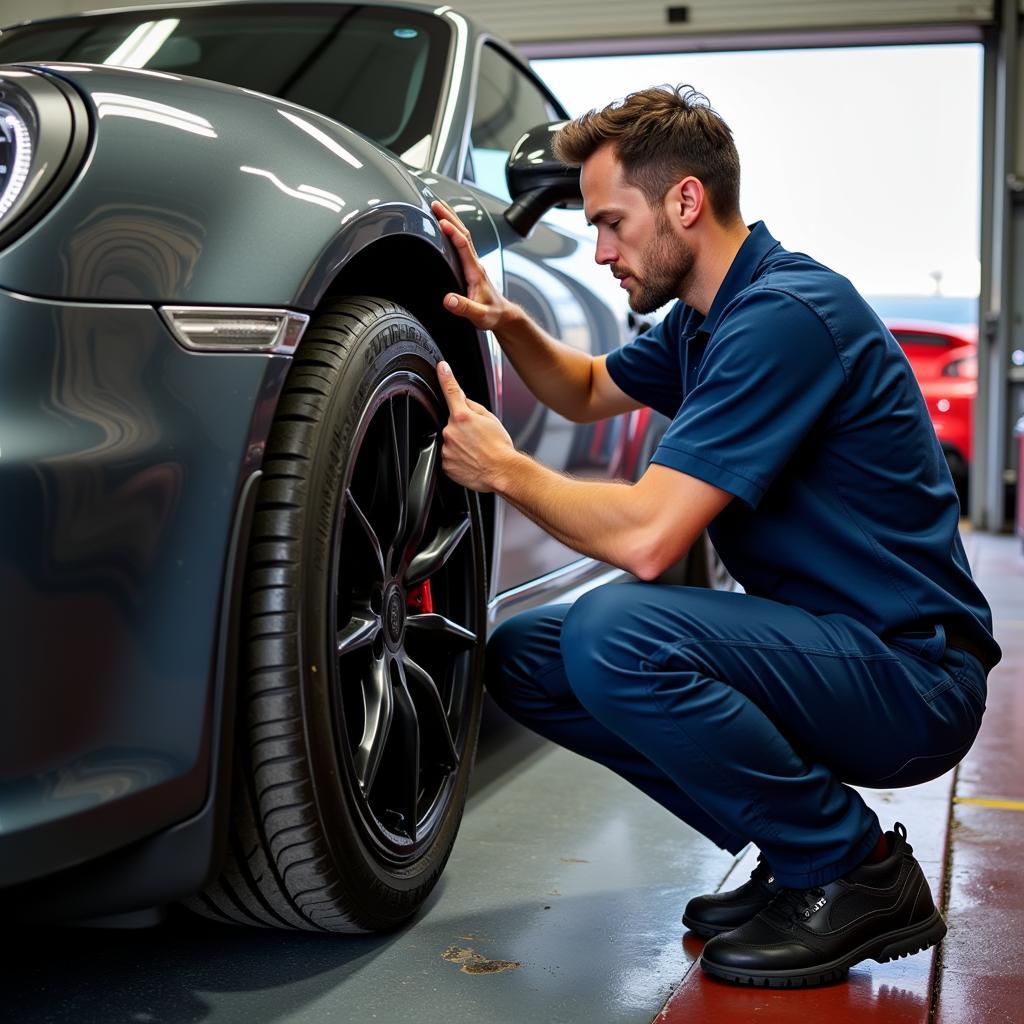Track days are exhilarating, pushing both you and your car to the limits. However, this intense driving can take a toll on your vehicle. Proper Car Maintenance After Track Day is crucial to ensure its longevity and performance. This article provides a comprehensive guide to post-track day car care, covering everything from basic checks to more advanced maintenance procedures.
 Post-Track Day Car Inspection
Post-Track Day Car Inspection
Essential Checks After Every Track Day
After an adrenaline-pumping day at the track, it’s essential to perform some basic checks before hitting the road again. These checks can help identify potential problems early on, preventing further damage and ensuring your safety.
- Tire Pressure and Condition: Check your tire pressure and look for signs of excessive wear, blistering, or punctures. Track driving generates significant heat, which can dramatically affect tire pressure.
- Brake Inspection: Inspect your brake pads and rotors for wear and tear. Track use puts a heavy strain on your brakes, so regular checks are vital.
- Fluid Levels: Check your engine oil, coolant, brake fluid, and power steering fluid levels. Top up any fluids as needed.
- Leaks: Look for any signs of leaks under the car. Oil, coolant, or brake fluid leaks can indicate serious problems.
- Lights: Check all your lights, including headlights, taillights, brake lights, and turn signals.
In-Depth Car Maintenance After Track Day
Beyond the basic checks, a more thorough inspection and maintenance routine is necessary after a track day. This ensures your car remains in optimal condition for future track events and everyday driving.
Why is Post-Track Day Maintenance So Important?
High speeds, hard braking, and aggressive cornering put immense stress on your car’s components. Ignoring post-track day car maintenance can lead to premature wear and tear, costly repairs, and even dangerous driving conditions.
- Oil Change: Track driving puts extra stress on your engine oil. Changing the oil and filter after a track day is highly recommended, even if you haven’t reached your regular oil change interval. You may be wondering about estimated annual maintenance costs car.
- Brake System Inspection: A detailed brake inspection should include checking the brake lines, calipers, and rotors for any damage or leaks. Consider flushing your brake fluid if it’s been a while.
- Suspension Check: Inspect your suspension components, including shocks, struts, and bushings, for wear and damage. Track driving can put extra strain on these components.
- Cooling System Flush: A coolant flush after a track day can help prevent overheating and maintain your engine’s temperature within optimal range.
“Regular maintenance is the key to maximizing the lifespan and performance of your vehicle, especially after demanding track sessions,” says Michael Davies, Automotive Engineer at Apex Motorsports.
What if I Hear Unusual Noises After a Track Day?
Unusual noises after a track day should never be ignored. They can be a sign of a developing problem. Common noises include grinding, knocking, or squealing.
- Grinding noises: Grinding noises from the brakes could indicate worn brake pads.
- Knocking noises: Knocking noises from the engine could be a sign of a serious internal problem.
- Squealing noises: Squealing noises could come from the belts, brakes, or other rotating components.
“Don’t underestimate the importance of addressing unusual noises promptly. Early detection can save you time and money in the long run,” advises Sarah Mitchell, Lead Mechanic at Trackside Auto.
Conclusion
Car maintenance after track day is essential for preserving your car’s performance and longevity. By following the guidelines outlined in this article, you can ensure your vehicle is ready for the next exhilarating track experience. If you need expert advice or assistance, feel free to contact us at AutoTipPro. Our number is +1 (641) 206-8880 and our office is located at 500 N St Mary’s St, San Antonio, TX 78205, United States. We can also help you with how to estimate maintenance costs for a used car.
FAQ
-
How often should I change my oil after a track day? It’s generally recommended to change your oil and filter after every track day, especially if it involves intense driving. You might want to consider estimated car maintenance costs.
-
What are the most common problems after a track day? Common issues include brake pad wear, tire wear, fluid leaks, and overheating. It’s also worth looking into estimated costs car maintenance.
-
Do I need special tools for post-track day maintenance? While some specialized tools can be helpful, many basic checks and maintenance tasks can be performed with standard tools. Thinking about maintenance costs? Check out estimated car maintenance costs in austin tx.
-
Can I perform track day maintenance myself? If you have mechanical experience, you can perform some maintenance tasks yourself. However, for more complex procedures, it’s best to consult a qualified mechanic.
-
How can I prevent brake fade during a track day? High-quality brake pads and fluid, proper cooling, and controlled braking techniques can help prevent brake fade.
-
What should I do if my car overheats on the track? Pull over immediately and let the engine cool down. Check the coolant level and look for leaks.
-
How can I extend the life of my tires during track days? Proper tire pressure, appropriate tire compound, and smooth driving techniques can help extend tire life.




Leave a Reply